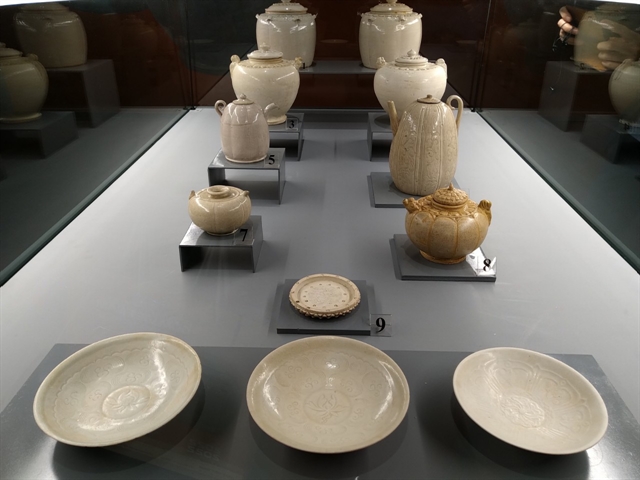 Life & Style
Life & Style

Some 80 ceramic pieces, representing the pottery making history of Việt Nam, are being exhibited at the National Museum of Vietnamese History in downtown Hà Nội.
HÀ NỘI — Some 80 ceramic pieces, representing the pottery making history of Việt Nam, are being exhibited at the National Museum of Vietnamese History in downtown Hà Nội.
Most of the objects belong to the antique collection of Trần Đình Thăng, a businessman from the northern coastal city of Hải Phòng, while the rest are from the museum’s stock.
Titled 'Vietnam ceramics: A Separate Tradition – From the An Biên Collection', the event aims to celebrate Vietnamese Heritage Day on November 23.
An Biên is the old name Hải Phòng, dating back to the time of the female hero Lê Chân. She named the area after her homeland in An Biên Village, in today’s Đông Triều District, Quảng Ninh Province.

|
| A visitor photographs a crackle-glazed statue of Bodhisattva, made in Bát Tràng in the 19th century. — VNS Photo Minh Đức |
Lê Chân gathered young people to practise martial arts to fight against invaders from the north. Her army then joined that of the two Trưng Sisters in a resistance movement in AD40-43, the first of its kind by Vietnamese people against the northern invaders.
After the war, Lê Chân continued to lead locals to reclaim wasteland to farm and live on.
Nguyễn Văn Đoàn, director of the museum, said the exhibition showcases a variety of glazed ceramic wares with high fine art values from 2,000 years of Vietnamese pottery making history.
“The exhibited objects are not very old but they are unique, including Bát Tràng wares, which had been made with exquisite details,” he said. “They include objects used by royal members and buried in ancient tombs.”
He said the exhibition does not introduce expensive antiques to astonish the audience but instead focuses on the appearance of Vietnamese ceramic wares from the past 2,000 years.
“The objects are divided into four topics of various genres of glaze,” he said.
The ceramic wares of the ten centuries since the beginning AD include objects made in traditional techniques of Đông Sơn civilisation (800-200BC) in styles relating to China. Back then, artisans made ceramic parts from moulds, then assembled the parts to be glazed and baked at high temperatures in kilns.
This was the beginning of glazed ceramic wares of the Lý (1009-1225) and Trần (1225-1400) reigns.
Between the 11th and 14th centuries, Vietnamese artisans created special creative patterns on pottery wares, which was the golden time of handicraft ceramic making in the country.
Popular objects included jars, water holders, worship objects, bowls and plates, used everywhere from royal palaces to ordinary homes.
There were various genres of glaze in the 14th century including white, jade, green, brown, brown flowery and blue flowery glaze.
In the 15-17th centuries, trade between Việt Nam and the rest of the world was promoted.

|
| A jar, in the form of a modified tiger, dating back to first to third century AD. — VNS Photo Lê Hương |
Ceramic wares were among the most sought-after goods for export.
Objects included daily utensils and worship objects glazed in blue flowery and decorated with dragons, phoenixes, and clouds.
Some areas famed for producing pottery were Thăng Long Citadel and Bát Tràng Village (today’s Hà Nội); Nam Sách and Bình Giang (in Hải Dương Province).
At the exhibition, Bát Tràng pottery wares from the 18th and 19th centuries are featured. They include daily utensils, worship objects and decorative objects of crackle glaze and blue glaze.
Phạm Quốc Quân, the former director of the museum, said all the antiques are valuable heritage items from the country's ancestors.

|
| White glazed wares from the Lý - Trần reign. — VNS Photo Minh Đức |
“There are distinguished groups of objects like white glaze wares made during the Lý reign with simple lotus decoration, which represents Buddhism among the people of the time,” he said.
“I think the collection is really valuable and sufficient to feature the history of ceramic development in Việt Nam,” he added.
The exhibition will run till the end of this year at the museum, No 1 Tràng Tiền Street, Hoàn Kiếm District, Hà Nội. VNS




